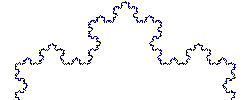Renormalising dynamical systems
In
a general sense, dynamics has two goals: to describe the typical behaviour
of trajectories for many systems (of any kind: physical, biological,
economic...)
as time tends to infinity, and to understand how this behaviour changes
with perturbations. The natural question that arises then is to know to
what extent a system is stable. That is, we want to find whether it is
possible to deform a perturbed system in a way such that we recover the
original one. In that case we call the systems equivalent or conjugated,
so that the qualitative behaviour (sometimes also quantitative) of the
trajectories of each system can be studied on the other one. This task
is not easily done and understood for most of the non-linear systems,
even the simplest ones. The order of complexity (the so-called chaos)
of the solutions can sometimes be too hard to tackle, turning all of
the known scientific techniques obsolete.
The
idea of "re-normalising" came from physics, inspired by the scaling laws
that one observes in phase transitions and their explanation from statistical
mechanics. In the late 1970's, Feigenbaum and, independently, Coullet and
Tresser performed numerical experiments with one-parameter families of
unimodal maps of the interval. They found a remarkable property: the existence
of a universal scaling law realised in a constant that appears in the transition
between regular and chaotic dynamics. This discovery called for a reflection
on the established idea of absence of order in mathematical chaos. The
value of the ``Feigenbaum constant'' seems to be common for all such systems,
and a renormalisation explanation was proposed for its existence. More
specifically, by defining a special scaling transformation in an appropriate
space of dynamical systems, the existence of a hyperbolic fixed point with
a one-dimensional unstable manifold corresponding to the universal behaviour
was conjectured. This is an important result recently proved by the continuous
efforts of Sullivan, Lyubich
and 1998's Fields medallist McMullen,
but extensions for larger dimensions and more "real" systems remain undone.
MacKay also found
this kind of behaviour numerically for the break up of the invariant tori
in two-dimensional area-preserving maps. He constructed a renormalisation
operator acting in the space of pairs of commuting maps and developed the
same ideas for volume-preserving flows. Others like Stark,
Khanin and Sinai have also
contributed in these directions.
The
renormalisation method can be used to study vector fields on the multidimensional
torus close to the linear flow. Thus to prove the local analytic equivalence
of flows to the linear one with generic frequency. In a particular case
one obtains Arnol'd's
famous solution to the problem of local analytic circle diffeomorphism
conjugacy to a rotation. Roughly, the renormalisation group technique analyses
systems on longer time scales and smaller spatial scales, generating a
new system. By iterating this we may get convergence to a limiting behaviour,
preferably a fixed point. In such a case, we get self-similarity (which
can be non-trivial depending on the problem). The application of this procedure
for more complicated systems like Hamiltonian vector fields is also possible.
The well-known work of Kolmogorov, Arnol'd
and Moser (KAM theory) showed that invariant tori, typical of integrable
Hamiltonian systems of more than one degrees of freedom, persist under
small perturbations. This achievement was very important as it finally
proved the long-standing "Ergodic Hypothesis" wrong. The main idea of the
earlier proofs of the KAM Theorem is to find sequences of canonical coordinate
changes which, in the limit, reduce the original Hamiltonian function to
an integrable one. That is not always possible because of the divergence
associated with the existence of small denominators in the generating functions.
The improvement of this theory is the construction of an operator (the
renormalisation) that asymptotically separates two distinct classes of
Hamiltonians: those with invariant tori with a given frequency in phase
space, and those without. The border between these classes will be the
set of Hamiltonians with a critical torus on the verge of breaking up.
This idea was mainly developed in the works by Koch, Abad,
Jauslin and Chandre
in recent years. The generalisation of their definitions and results
of the renormalisation operator to a larger set of frequencies and higher
dimensions remains undone.
There are some applications that may arise from this study. As any system
that evolves in time (or is an iterative process) is a dynamical system,
the sort of questions above can be of fundamental importance in disciplines
as different as genetics, engineering, finance, geophysics, thermonuclear
fusion or celestial mechanics. In fact, much work has already been done
in those areas based on the dynamical systems theory, despite being a pure
mathematical discipline. The essential characteristic of those systems
is the nonlinearity of the ruling equations, which makes them unsolvable
and chaotic.

non-twist map
strong persistence of the twistless
torus
João Lopes Dias
31st January 2001
~ Cambridge ~ England ~
